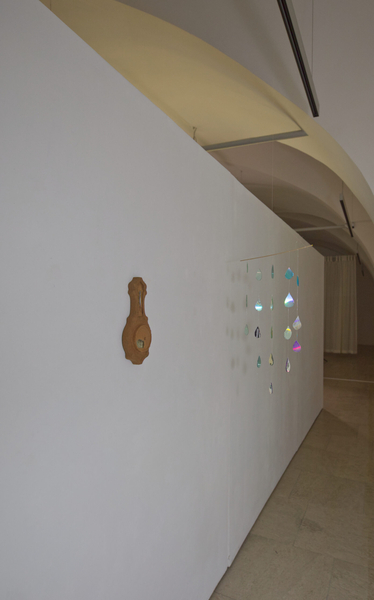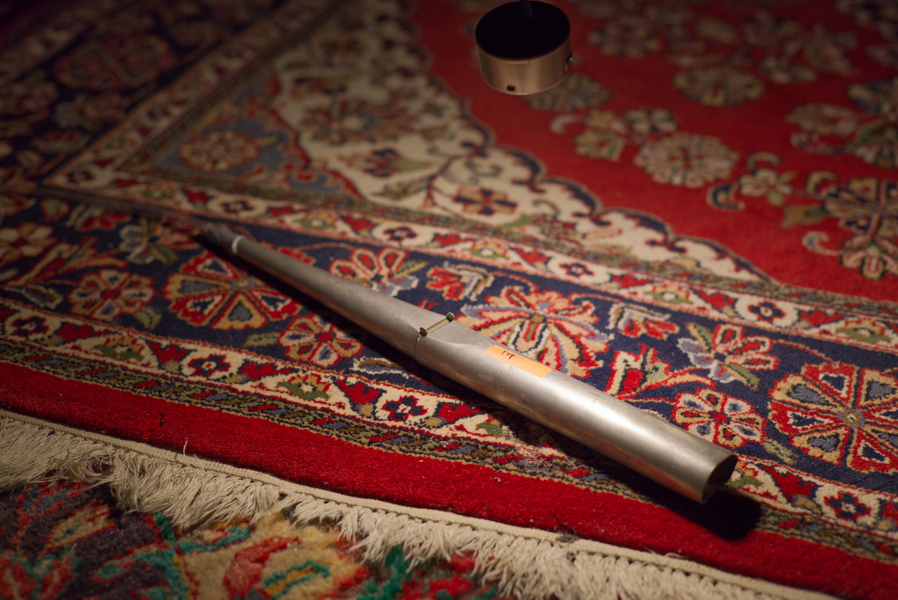L.A.S.S.O. | Marie-Andrée Pellerin – windbusting

11. – 20.12.2024
Eröffnung
Mi, 11.12.2024
19.00
Finissage
Fr, 20.12.2024
16.00-19.00
with punch!
In the early days of modern meteorology, in the first decades of the 20th century two Norwegian scientists, Vilhelm and Jacob Bjerknes studied the role of the exchange of cold and warm masses of air. Around 1920, just after World War I, they introduced the term “front” to describe the edges of large cold and warm air waves. Borrowed from militaristic vocabulary, the word metaphorically represents the potential violence unleashed when two fronts meet. Around the same time, in order to graphically represent that concept the weather maps as we know them today were born. Lines with spiky triangular barbs represent cold fronts and lines with soft semicircular pips stand for warm fronts. Weather forecasting as an applied discipline was historically connected to the military, the navy and agriculture. The science developed fast as it proved the value of its practical use, especially with the introduction of modern media, such as telegraph and radio, when information can travel faster than the wind. One can trace the change of attitude towards meteorology in the different words starting with “probabilities” through “indications” and “predictions” to “forecasting”.
Alongside the development of meteorology, the idea emerged not only to predict weather changes but also to induce them. Weather modification techniques, like cloud seeding, were developed by the late 19th century. This method disperses material into the air to increase rainfall or snowfall. Some methods proved effective, while others, like cloudbusting, developed by Austrian psychoanalyst Wilhelm Reich in the 1950s, were based on pseudoscientific premises.
The practice of televised weather forecasts is relatively new, it started with the first ever TV broadcast by BBC in 1936. Only after World War II and the rise of popularity of the TV medium weather reports became standard and regular broadcasts worldwide. Kairos TV takes its name from a Greek word, Kairos. In modern Greek it stands for weather or time, in ancient Greek it means a right or a critical moment, a decisive time. In Greek mythology Kairos (or Caerus) is a god of luck, opportunity and fleeting moment. The connection between time and weather makes it a perfect choice for the name of a weather forecasting channel.
The news ticker on Kairos TV displays a scrolling text, a fragment of an 1819 poem by Percy Bysshe Shelley “Ode to the West Wind”. In European tradition, the mildest of winds and the harbinger of spring is the West Wind, also known as Zephyr, a messenger of change and revolution. In modern media, news ticker, scrolling text sometimes called the crawler, is usually associated with “breaking news” information, on sudden and unexpected changes or fluctuations in the stock exchange. The dissonance between the real threat, the cold and warm fronts meeting, and building up of a cyclone which will create a sandstorm is interrupted by a “news” from the beginning of the 19th century. But hey it’s good news!
The visualisation of something so ephemeral and changing as wind requires movement, the film as a moving image medium can capture the slight changes in the atmosphere much more easily than a still image or a map. The wind sets the things in motion itself. The only moment the observer realises the presence of the wind is when it encounters an obstacle. The object will act, turn, slide, fly or whistle, flap, slat, rattle and clatter etc. Thus, the other indicator revealing the air movement is the sound.
The most popular scale for measuring wind force was developed around 1805 by British Navy officer Francis Beaufort. It has been widely used ever since. The scale is based on observations, correlating wind strength with the movement of objects or the potential damage caused. For example, Vento moderato (Italian for “moderate breeze”), ranked as number 4 on the Beaufort Scale, describes conditions on land as: “raises dust and loose paper; small branches move.”
In various cultures the winds and other weather phenomena are associated with gods or deities. In ancient Greek religion and mythology, the winds were subjects to their ruler, the god Aeolus, a king of a floating island of Aeolia, where he kept the winds imprisoned in a cave. He can release the winds, summon storms or calm turbulent seas at his will, by hiding the winds in a giant bag. In the myths Anemoi the winds themselves were minor gods. The deity of the southwestern wind was called Lips, in Roman mythology his name was Africus.
In several traditions winds are dangerous not only because of physical damage, havoc and devastation that they bring. Some winds can induce madness. In Polish folklore, for example the wind Halny (a type of so-called Föhn Wind a warm windstorm descending from the mountains into the valleys) is believed to bring insanity and madness. In the 19th century at the University in Munich, an Austrian physician, Anton Czermak studied the correlation between the winds and mental conditions. Sirocco (from Arabic šurūq – “east”), is a wind in Mediterranean coming from Sahara and reaching hurricane speeds. It is so powerful it could move the dust over the sea, and when the dusty air mixes with humidity, it can rain in red-tinted drops. It is believed that one can adapt to sirocco or be lost.
Marie-Andrée Pellerin’s video Blowrders was filmed in 2024 in Morocco, on Sahara Desert, in the proximity of the border with Algeria. The artist visited this location in the framework of an art residency – Ansible Institut at Café Tissardmine in 2022 and 2024. This desolate region is marked by a territorial conflict and the incompatibility of a system of fixed land borders with the culture of the local population of Amazigh (Berber) people, who are traditionally nomadic. The wind that blows on the Sahara literally blows through the borders, which are not only lines on the map but often solid walls and fortified structures.
Steve the haboob (Dust Storm, Sandstorm, habb Arabic – “to blow” or “wind”) announced by the forecaster from the Kairos TV moved the sand from Sahara thousands of kilometres north, and in March 2024 it covered the snowy peaks of the Alps with a strange yellow and orange dust.
Curated by Stanisław Welbel
Collaborators / facilitators:
Ansible Institute ([M] Dudeck and Martina Raponi) – residency organisation
Stephanie Bergwink, performance
Brandon Gibson-DeGroote, sound composition and mastering
Karen Hadfield, Café Tissardmine‘s host and facilitator / Morocco
Clemens Mairhofer and Hansi Raber, technical support
Cristina Ramovecchi, voice (Wind Museum, Trieste)
Stanisław Welbel, text, sound effects and wind catching
Reinhard Zach, camera and montage assistance
Special contributions by François Lemieux, Judith Maule and the Bora Museum / Trieste
x ༄ x ༄ x ༄ x
Mit Unterstützung der Vertretung der Regierung von Québec in Deutschland, Österreich und der Schweiz, Conseil des arts et des lettres du Québec und Canada Council for the Arts.


Die Serie L.A.S.S.O. zeigt Arbeiten Linzer Künstler*innen die ein Salzamt oder Linz AG Atelier nutzen.
Local Artists Solo Show Observations
Öffnungszeiten
Di und Mi
11.30 – 14.00
Do und Fr
11.30 – 18.00




















